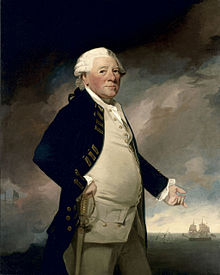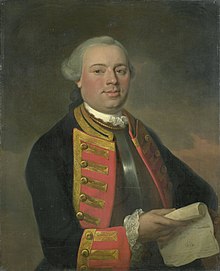Battle of Dogger Bank (1781)
| Battle of Dogger Bank | |||||||
|---|---|---|---|---|---|---|---|
| Part of the Fourth Anglo-Dutch War | |||||||
 The Battle of Dogger Bank, Thomas Luny | |||||||
| |||||||
| Belligerents | |||||||
|
|
| ||||||
| Commanders and leaders | |||||||
|
|
| ||||||
| Strength | |||||||
|
7 ships of the line 5 frigates 1 cutter 3,500 men[1] 442 guns[1] |
7 ships of the line 6 frigates 2,600 men[1] 408 guns[1] | ||||||
| Casualties and losses | |||||||
|
104 killed 339 wounded[2] |
142 killed 403 wounded 1 ship of the line sunk[2][note 1] | ||||||
The Battle of Dogger Bank was a naval battle that took place on 5 August 1781 during the Fourth Anglo-Dutch War, contemporaneously related to the American Revolutionary War, in the North Sea. It was a bloody encounter between a British squadron under Vice Admiral Sir Hyde Parker and a Dutch squadron under Vice Admiral Johan Zoutman, both of which were escorting convoys.
Background
In December 1780, Great Britain declared war on the Dutch Republic, drawing it militarily into the American War of Independence.[3] The Dutch had for several years been supplying the Americans and shipping French supplies to the Americans, in support of the American war effort, the reason behind the British declaration of war.[4] The opening of hostilities with the Dutch meant that Britain's trade with countries on the Baltic Sea—where key supplies of lumber for naval construction were purchased—was potentially at risk, and that the British had to increase protection of their shipping in the North Sea. In order to accomplish this, the British began blockading the Dutch coast to monitor and intercept any significant attempts to send shipping into or out of Dutch ports, and began to protect merchant shipping convoys with armed vessels.

The Dutch were politically in turmoil, and were consequently unable to mount any sort of effective actions against the British.[5] The result of this inaction was the collapse of their economically important trade.[6] It was finally decided that a merchant fleet had to be launched. On 1 August 1781, Admiral Johan Zoutman led a fleet of some 70 merchantmen from the Texel, protected by seven ships of the line as well as a number of frigates and smaller armed vessels. Admiral Sir Hyde Parker was accompanying a convoy of ships from the Baltic when he spotted the sails of the Dutch fleet at 04:00 on the morning of 5 August. He immediately despatched his convoy toward the English coast, and ordered his line to give chase rather than prepare for battle.[7]: 48 Zoutman, whose ships had been interspersed with the merchantmen, signalled his line to form in between Parker and the convoy. The ships of Parker's fleet were not in the best of condition, since great demands were placed on the Royal Navy by the demands of the war, and all manner of ships were pressed into service, or did not receive necessary maintenance. Some ships were in such poor condition that the number of guns available to fire was reduced from its normal complement. The ships had had no time to practise the normal fleet manoeuvres.[7]: 46 In spite of this, Berwick and Parker's flagship Fortitude, both 74 guns, were both relatively new and in good shape. The Dutch crews were inexperienced as they had not seen any significant action due to the British blockade.
Battle

With a calm sea and a breeze from the north-east, Zoutman manoeuvred his line onto a port tack, heading south-east by east, and awaited Parker, who held the weather gage. The British fleet closed, raggedly at first due to the poor condition of some of the ships, into a line of battle abreast in accordance with the signal raised at 06:10. Two ships were told to change places, which led to a mistake and placed the Dolphin against one of the largest Dutch ships and the Bienfaisant without an opponent.[7]: 48 When Parker raised the battle flag shortly before 08:00, for close action, the British fleet moved closer. Surprisingly, the Dutch ships did not fire as the British approached until the two fleets were about half a musket shot apart. Zoutman then also raised his flag and opened fire, raking the Fortitude with a broadside. Close action ensued, lasting for three hours and 40 minutes.[7]: 49 Around mid-morning, the Dutch merchantmen moved away from the action and headed back to Texel. At 11:35, Parker gave the signal to reform his line as the ships had become unmanageable. His fleet dropped to leeward and manoeuvered to reform their line of battle.[7]: 50 However, the British ships were so damaged that this didn't succeed, which meant that Parker was unable to resume the fight again. For nearly half an hour Zoutman, with his heavily damaged ships, remained at the place where the British had left him as proof that he had secured the battlefield.[8] He then sailed back to the Dutch Republic.[1]

Casualties on both sides were high, considering the number of ships involved. Fewer casualties were suffered, for example, in the battle of the Chesapeake, fought a month later between fleets more than twice as large. The British reported their losses at 104 killed and 339 wounded, while the Dutch reported their losses at 142 killed and 403 wounded. While Dutch losses from the battle were well documented,[9] naval historian William Laird Clowes noted that certain unconfirmed reports suggested that the Dutch casualties were actually much higher, possibly reaching 1100 killed and wounded.[2] The heavily damaged Holland sank later that night. The Belle Poule came upon her; her colours, still flying, were captured and carried to Parker.[10]
Aftermath
Both sides claimed victory and both convoys escaped. The British had first abandoned the fight. However, the Dutch had lost a ship of the line sunk and in addition, strategically, the battle was a British victory since the Dutch fleet retreated to Texel and did not leave harbour again during the war. In addition, Dutch merchant trade remained crippled by the constant capture of their merchantmen by British privateers.[11] At least one convoy made it to the Baltic, but it flew under the Swedish flag and was accompanied by a Swedish frigate.[12]
Parker, on his return, considered that he had not been properly equipped for his task. On arrival at the Nore, met King George III and told him: "I wish Your Majesty better ships and younger officers. As for myself, I am now too old for the service".[7]: 52 He then resigned his command.
In the Dutch Republic, however, the battle was celebrated as a victory. The last major battle the Dutch fleet had fought before the Battle of Dogger Bank was the Battle of Málaga in 1704, and now the Dutch fleet had held its ground against the British fleet. The Dutch commanders were showered with praise and a wave of enthusiasm erupted in the Dutch Republic. The fact that the battle had failed to change the strategic situation was ignored.[13]
Order of battle
BritishShips of the line
Other vessels with the fleet
With the convoy
Source:[14] |
DutchShips of the line
Other vessels with the fleet
With the convoy
|
Notes
- ^ Holland, a 68-gun Dutch ship of the line, sank after the battle.
References
- ^ a b c d e Van Nimwegen 2023, p. 228.
- ^ a b c Clowes 1898, p. 508.
- ^ Edler 2001, p. 343.
- ^ Davies 1851, p. 469.
- ^ Edler 2001, pp. 169–176.
- ^ Davies 1851, p. 468.
- ^ a b c d e f Ross, Sir John. Memoirs of Admiral de Saumarez Vol 1.
- ^ De Jonge 1843, p. 629.
- ^ Medische Aspecten van de Slag bij Doggersbank
- ^ Allen 1852, p. 319.
- ^ Syrett p. 131
- ^ Davies 1851, p. 472.
- ^ Brand 2010, p. 24.
- ^ Clowes 1898, p. 505.
Bibliography
- Allen, Joseph, Battles of the British navy, Volume 1 H. G. Bohn, London,(1852)
- Blok, Petrus Johannes. History of the People of the Netherlands
- Clowes, Sir William Laird (1898). The Royal Navy: a history from the earliest times to the present, Volume 3
- Davies, Charles Maurice. The history of Holland and the Dutch nation, Volume 3
- Edler, F. (2001) [1911]. The Dutch Republic and The American Revolution. Honolulu, Hawaii: University Press of the Pacific. ISBN 0-89875-269-8.
- Penrose, John (1850). of Vice-Admiral Sir Charles Vinicombe Penrose, K. C. B., and Captain Trevenen. J. Murray (publisher), Harvard University.
- Syrett, David (1998). The Royal Navy in European Waters During the American Revolutionary War Studies in maritime history. Univ of South Carolina Press. ISBN 9781570032387.
- Brand, Ron (2010). Zeehelden, kooplieden, lords en ladies op kasteel Keukenhof [Sea heroes, merchants, lords and ladies at Keukenhof Castle] (in Dutch). Verloren. ISBN 9789087041700.
- Van Nimwegen, Olaf (2023). Willem V: De laatste stadhouder van Nederland 1748-1806 [William V: The last stadholder of the Netherlands 1748-1806] (in Dutch). Prometheus. ISBN 9789044648218.
- De Jonge, Johannes Cornelis (1843). Geschiedenis van het Nederlandsche zeewezen Deel 5: Van den Utrechtschen Vrede, Ao. 1713, tot den zeeslag van Doggersbank, Ao. 1781. Dl. 5, Deel 5 (in Dutch). Van Cleef.
External links
 Media related to Battle of Dogger Bank (1781) at Wikimedia Commons
Media related to Battle of Dogger Bank (1781) at Wikimedia Commons
